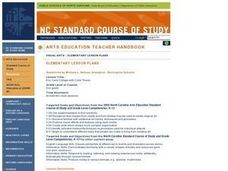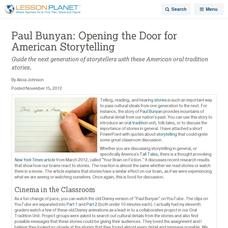Curated OER
Illuminating Language in Love's Labor's Lost
Students reflect on literature using multiple intelligences. In this literature analysis lesson, students make creative visual representations of vocabulary terms from a speech in the play. They work in small groups to...
Curated OER
Heart Healthy Food Musical Chairs
Students participate in a game of musical chairs that discusses heart health. In this health lesson plan, students walk around a group of chairs and when the music stops they sit down. Some chairs will have index cards with a picture of...
Curated OER
Eric Carle Collage with Color Theory
Second graders analyze color theory and collage techniques through the creation of collages in the style of artist/author Eric Carle. Color experiments and may hands-on section allow this lesson to be very informative and fun for the...
Curated OER
Out of the Dust -- Part II
Eighth graders discover that literature can be a great way to gather information about the past. Using various types of text, they research its historical data and determine if it is correct. They write two papers to respond to the...
Curated OER
The Death of the Ball Turret Gunner
Pupils read and analyze a poem about a speaker's posthumous view of war, assess the purpose of an author's note and evaluate the effect of the point of view on the reader's response. They work in groups to discuss and analyze the poem.
Curated OER
Dealing with Growth and Change
Students discuss the right and wrong actions of a young Navajo boy. Using that information, they compare and contrast his culture to their own. In groups, they create a newspaper or poster showing the cultural contributions of the...
Curated OER
Where Is Hoku?
Learners are introduced to map making and reading. Using maps, they identify the cardinal directions and discuss the importance of a legend. They analyze the human characteristics of the classroom and create overhead view maps of the...
Curated OER
Paul Bunyan: Opening the Door for American Storytelling
Guide the next generation of storytellers with these American oral tradition stories.
Curated OER
Sneetches by Dr. Seuss
Learners read "Sneetches" by Dr. Seuss. They complete a story map and write about the topic of prejudice. They role-play star-bellied and plain-bellied sneetches and write a persuasive essay about their experiences.
Curated OER
How the Environment Effects our Feelings
First graders compare images and discuss their feelings created by an artist's work. They explore the correlation between experiencing feelings in art and literature and feelings caused by changes in weather.
Curated OER
Jobs on a Ship
Students facilitate each student's comprehension of the different jobs on a ship and the job's evolutions over time. They compare/contrast certain jobs on a ship from history to today. Students work together in cooperative groups to...
Curated OER
The Nature of the Antagonist
Students explain the differences between protagonists and antagonists and recognize the fundamental purpose of an antagonist or villain in storytelling. They also explain conflict as used in literature.
Curated OER
People and Places in Indiana's Underground Railroad
Fourth graders use an Indiana map to explain why Indiana's geographic location was important to its role in the UGR. They experience personal stories and feelings of the people involved in UGR through role-play and literature.
Curated OER
Five "E" Lesson-Stereotypes
Students discuss the nature of stereotyping and prejudicial behavior and their feelings regarding people with visible disabilities. They view part of documentary Graduating Peter then work in groups to chart people's reactions and...
Curated OER
Immigrants & Community
Students examine how different groups of immigrants contributed to the growth of specific communities. After reading a novel, they keep a journal on the important elements found and create a map of the community portrayed. Using the...
Curated OER
Read "El Corrido de Gregorio Cortez"Americo Paredes version
Students see examples of other types of written stories. They are introduced to the ballad in literature. Students obtain ideas for their own family story. They discuss how ballads can relate true stories through music. Students discuss...
Curated OER
Alaska's Cultures: Regions & Native Peoples of Alaska
Students read the essay "Did American Aborigines have Culture?". They discuss culture and what is meant by culture.
Curated OER
Hearing the Poetry of Langston Hughes Through the Sounds of Jazz
Students have an appreciation of Langston Hughe's poetry and his use of jazz rhythms, have the ability to read poetry closely, and freewrite to gain a fresh perspective on music and literature.
Curated OER
Using Alliteration in The Z was Zapped
Young scholars discuss alliteration and how it is used in the book The Z Was Zapped. Students choose a letter and create alliterative sentences and illustrate the letter.
Curated OER
Let's Recreate Our World To Make It Better
Students examine art by artist by Tom Rollins. They discuss the painting and what it means to them. They create their own models of apartment complexes based on ideas from literature.
Curated OER
English Novel: Fallen Angels
Students work in literary circles to discuss the novel Fallen Angels. In this Fallen Angels lesson plan, students find quotations, make connections, and identify themes as they discuss the novel. Students discuss...
Curated OER
Writing a Mystery Story
Learners examine the elements of mystery stories and read Rage in Harlem. In reciprocal teaching groups, they discuss the author's development of the story, and complete dialectical journals.
Curated OER
"The Five Orange Pips" Lesson
Seventh graders read sections of a Sherlock Holmes novel. They identify references to hate groups that are the criminals in the story. They discuss the symbols found in the story.
Curated OER
Lifestyles of the Tribe, or Tomorrowland?
Eighth graders identify with and analyze through writing various Indian cultural values and how they fit in the modern world. Students organize data utilizing Educational software programs and present their opinions and inferences in a...

























